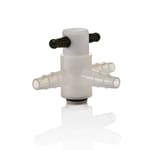Search Thermo Fisher Scientific

Stopcocks
Stopcocks work as valves, serving to regulate, interrupt, or completely stop gas or liquid flow through piping, tubing, or a faucet, with tubes attached to the stopcock’s female joint, easily separated or connected by a turn of the stopcock. Stopcocks may be held in place by vacuum, rubber rings, or clips. Glass stopcocks need stopcock grease for lubricating and sealing the plug and shell. Glass stopcocks with plastic plugs are sealed without grease but are less effective for high vacuum. Plastic plug glass stopcocks, however, work well for low vacuum applications.
Products (2)
Learn More (5)
Documents & Support
(424)2 Products
Filter
Nalgene™ Three-way Stopcock Thermo Scientific™
Experience in-house fluid transfer system flexibility with a Thermo Scientific™ Nalgene™ Three-way Stopcock, arranged in a T-shape to connect any two — or all three — arms of the stopcock with ease.
Nalgene™ Stopcocks Thermo Scientific™
Permit reliable, accurate liquid flow control in liquid handling systems by using Thermo Scientific™ Nalgene™ Stopcocks. They are ideal for use in developing in-house fluid transfer systems for one-way fluid path for accurate filling or dispensing.
Learn More (5)
View all
Like the polyethylenes, polypropylene is classified as a polyolefin and is a high-molecular weight hydrocarbon. Polypropylene’s chemical structure is similar to polyethylene, but each unit of the chain has a methyl group attached.
Nalgene separatory funnels are a safer alternative to glass. They won’t break, chip or shatter amid the bustle and bumps of everyday lab work. Enjoy their light weight and ease of handling. Trust Thermo Scientific Nalgene separatory funnels to be made from the highest quality laboratory-grade...
Documents & Support (424)
View all
Product drawing: 006460000X_1200
Product drawing: 006470000X

